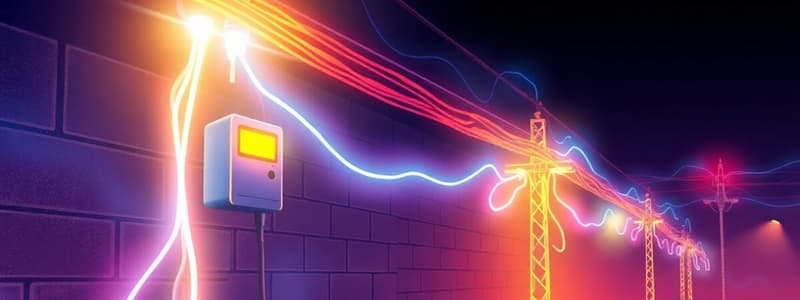Podcast
Questions and Answers
According to general electrical installation design, what is a crucial aspect to consider?
According to general electrical installation design, what is a crucial aspect to consider?
- The aesthetic appeal of the wiring system.
- Using the cheapest available materials.
- The color coordination of electrical cables.
- Adherence to rules and statutory regulations. (correct)
What does the acronym 'MV' stand for in the context of electrical distribution networks?
What does the acronym 'MV' stand for in the context of electrical distribution networks?
- Maximum Voltage
- Main Voltage
- Medium Voltage (correct)
- Minimum Voltage
What is the primary purpose of 'LV switchgear' in an electrical system?
What is the primary purpose of 'LV switchgear' in an electrical system?
- To regulate overvoltage protection schemes.
- To control and protect low voltage circuits. (correct)
- To measure reactive energy consumption.
- To step-up voltage levels for transmission.
Why is it important to compensate for reactive power in electrical installations?
Why is it important to compensate for reactive power in electrical installations?
According to the IEC 60364 series, what is the main focus of the standards?
According to the IEC 60364 series, what is the main focus of the standards?
To ensure the quality and safety of an electrical installation, what initial step must be achieved?
To ensure the quality and safety of an electrical installation, what initial step must be achieved?
What is the purpose of performing electrical continuity and conductivity tests during pre-commissioning?
What is the purpose of performing electrical continuity and conductivity tests during pre-commissioning?
What does RCD effectiveness verification ensure in an electrical installation?
What does RCD effectiveness verification ensure in an electrical installation?
How does the use of a star-delta starter affect the starting current of an induction motor?
How does the use of a star-delta starter affect the starting current of an induction motor?
Why is power factor correction important for induction motors?
Why is power factor correction important for induction motors?
Assuming $\cos \phi = 1$, how can the current demand of a heating appliance be determined?
Assuming $\cos \phi = 1$, how can the current demand of a heating appliance be determined?
In the context of fluorescent lamps, what does the power indicated on the tube not include?
In the context of fluorescent lamps, what does the power indicated on the tube not include?
For LED lamps, how does the inrush current at startup compare to fluorescent lamps with electronic ballasts?
For LED lamps, how does the inrush current at startup compare to fluorescent lamps with electronic ballasts?
When considering installed power in kW, what does the power rating on most electrical equipment represent?
When considering installed power in kW, what does the power rating on most electrical equipment represent?
When calculating the total kVA of apparent power, why isn't it a simple arithmetic sum of individual loads?
When calculating the total kVA of apparent power, why isn't it a simple arithmetic sum of individual loads?
What does the utilization factor (ku) account for in electrical installation design?
What does the utilization factor (ku) account for in electrical installation design?
What does a diversity factor (ks) of less than 1 indicate?
What does a diversity factor (ks) of less than 1 indicate?
In what situation is a diversity factor of 0.8 recommended for electrical heat-storage units in apartment blocks?
In what situation is a diversity factor of 0.8 recommended for electrical heat-storage units in apartment blocks?
In a multi-storey apartment building with vertical rising mains, how does the cross-sectional area of conductors change from lower to upper floors?
In a multi-storey apartment building with vertical rising mains, how does the cross-sectional area of conductors change from lower to upper floors?
According to the diversity factor for distribution switchboards, which type of load has a diversity factor of 1?
According to the diversity factor for distribution switchboards, which type of load has a diversity factor of 1?
In the formula $I_a = \frac{kVA \times 10^3}{U \sqrt{3}}$, what does 'U' represent?
In the formula $I_a = \frac{kVA \times 10^3}{U \sqrt{3}}$, what does 'U' represent?
When calculating the total apparent power demand (kVA) for an electrical installation, what factor is applied to individual loads to account for simultaneous operation?
When calculating the total apparent power demand (kVA) for an electrical installation, what factor is applied to individual loads to account for simultaneous operation?
What is one key consideration when selecting a suitable rating for a transformer in an electrical installation?
What is one key consideration when selecting a suitable rating for a transformer in an electrical installation?
When is it recommended to use shunt-connected capacitors with induction motors?
When is it recommended to use shunt-connected capacitors with induction motors?
What is the fundamental principle behind ensuring quality and safety in an electrical installation?
What is the fundamental principle behind ensuring quality and safety in an electrical installation?
Flashcards
Quality and safety of electrical installation
Quality and safety of electrical installation
Ensuring electrical installations meet quality and safety standards by adhering to wiring rules, relevant product standards, and conformity checks.
Initial testing of an installation
Initial testing of an installation
Pre-commissioning electrical tests include electrical continuity, conductivity tests, insulation resistance tests, SELV/PELV compliance tests, and protection against supply disconnections.
Periodic check-testing
Periodic check-testing
Periodic checks include RCD effectiveness, safety measurements against electric shock, protection against property damage from fire and heat, and identification of installation defects.
Rated current demand
Rated current demand
Signup and view all the flashcards
Reactive-power compensation
Reactive-power compensation
Signup and view all the flashcards
Power factor effect
Power factor effect
Signup and view all the flashcards
Current in fluorescent lamps
Current in fluorescent lamps
Signup and view all the flashcards
Installed Power
Installed Power
Signup and view all the flashcards
Nominal Power Rating
Nominal Power Rating
Signup and view all the flashcards
Installed apparent power (kVA)
Installed apparent power (kVA)
Signup and view all the flashcards
Factor of maximum utilization (ku)
Factor of maximum utilization (ku)
Signup and view all the flashcards
Diversity Factor
Diversity Factor
Signup and view all the flashcards
Rated Diversity Factors
Rated Diversity Factors
Signup and view all the flashcards
Choice of transformer rating
Choice of transformer rating
Signup and view all the flashcards
Study Notes
General Rules of Electrical Installation Design
- Rules and statutory regulations must be followed
- Power loads need to be properly installed, considering their characteristics
- Connections to both Medium Voltage (MV) and Low Voltage (LV) public distribution networks are essential
- LV distribution should be carefully planned to provide adequate power
- Protection against electric shocks and electrical fires are critical safety measures
- Sizing and protection of conductors is important for ensuring safe and efficient operation
- LV switchgear should have appropriate functions that meet the installation's needs
- Energy efficiency is crucial for reducing costs and environmental impact
- It is possible to use reactive energy by doing power factor correction
- Accurate energy measurement is necessary for monitoring consumption and optimizing performance
Regulations and Standards
- Quality and safety must be ensured for electrical installations including the wiring rules
- It must also ensure that electrical equipment complies with relevant product standards
- Initial checks are required to conform the electrical installation with standards and regulations
- Before connecting an installation to the supply network, strict pre-commissioning electrical and visual inspections are needed
- Electrical continuity and conductivity tests are crucial for protective, equipotential, and earth-bonding conductors
- Insulation resistance tests between live conductors and protective conductors must be performed where connected to the earthing arrangement
- Compliance tests of SELV (Safety Extra Low Voltage) and PELV (Protection by Extra Low Voltage) circuits must be performed or for electrical separation.
- Measure the Insulation resistance or impedance of floors and walls.
- Protection with automatic disconnection of the supply is also needed.
- Periodic check-testing is necessary verification of RCD (Residual Current Device) effectiveness and adjustments
- Appropriate measurements must be taken in providing safety against effects of electric shock and damage to property from fire and heat
- Confirmation that the installation is not damaged through this testing process.
- Identification of installation defects must occur
Installed Power Loads – Characteristics for Induction Motors
- The rated current I₂ supplied to the motor is given by the formulae: 3-phase motor: I₂ = Pₙ × 1000 / (√3 x U x η x cos φ), I-phase motor: I₂ = Pₙ x 1000 / (U x η x cos φ)
- Iₙ is rated current (in amps)
- Pₙ is nominal power (in kW)
- U is voltage between phases for 3-phase motors and voltage between the terminals for single-phase motors (in volts)
- η is per-unit efficiency (output kW / input kW)
- cos φ is power factor (kW input / kVA input)
- Induction motors have a motor starting current that can be reduced with a star-delta starter
- Compensation of reactive-power (kVar) in induction motors to reduce the current supplied to induction motors and can be achieved by using capacitors without affecting the power output of the motors
- The current supplied to the motor after power-factor correction is given by I = Iₐ * (cos φ / cos φ'), where cos φ is power factor before compensation and cos φ' is power factor after compensation. Iₐ is the original current.
Installed Power Loads – Characteristics for other Items
- For resistive-type heating appliances and incandescent lamps (conventional or halogen) The current demand of a heating appliance or an incandescent lamp can be obtained from the nominal power Pₙ quoted by the manufacturer when cos φ = 1
- Installation must consider the power Pn (watts) indicated on the tube of a fluorescent lamp which doesn't include the power dissipated in the ballast
- The current is given by I₂= (Pballast+Pn)/(U cos φ)
- U= voltage applied to the lamp
- Where no power-loss is indicated for the ballast, a figure of 25% of Pn may be used.
- cos ф = 0.6 with no-power factor correction capacitor
- cos ф = 0.86 with power factor correction capacitor (single or twin tubes)
- cos ф = 0.96 for electronic ballast.
- Discharge lamps which have longer start-up times must be installed
- To calculate the current in (amps) through a circuit, the equation la= (kVA10^3)/(Usqrt(3)) can be used. kVA being the maximum 3-phase apparent power circuit value, and U is the line voltage
- LED lamps or luminaires typically use a driver and has very short start-up times.
Power loading of an Installation
- Most electrical appliances and equipment are marked to indicate their nominal power ratiing (Pₙ).
- Total power is sum of power-consuming devices
- Power demands vary through utilization and diversity. (ku and ks)
- ku: factor of maximum utilization.
- ks: Diversity factor.
- The total kVA of apparent power that is supplied is not equal to the arithmetic sum of the calculated kVA ratings of individual loads, it should be optimized
- In order to select cable sizes for the distribution circuits of an installation, the current I (in amps) through a circuit is determined from the equation.
- Standard transformer rating is always needed when doing calculations.
Studying That Suits You
Use AI to generate personalized quizzes and flashcards to suit your learning preferences.




